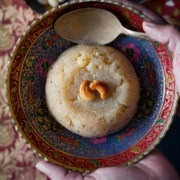Crumbly, sweet, and utterly delightful – that’s the essence of rava sheera, also referred to as suji ka halwa. Learn how you can whip up this easy, traditional Indian dessert in under half-hour.
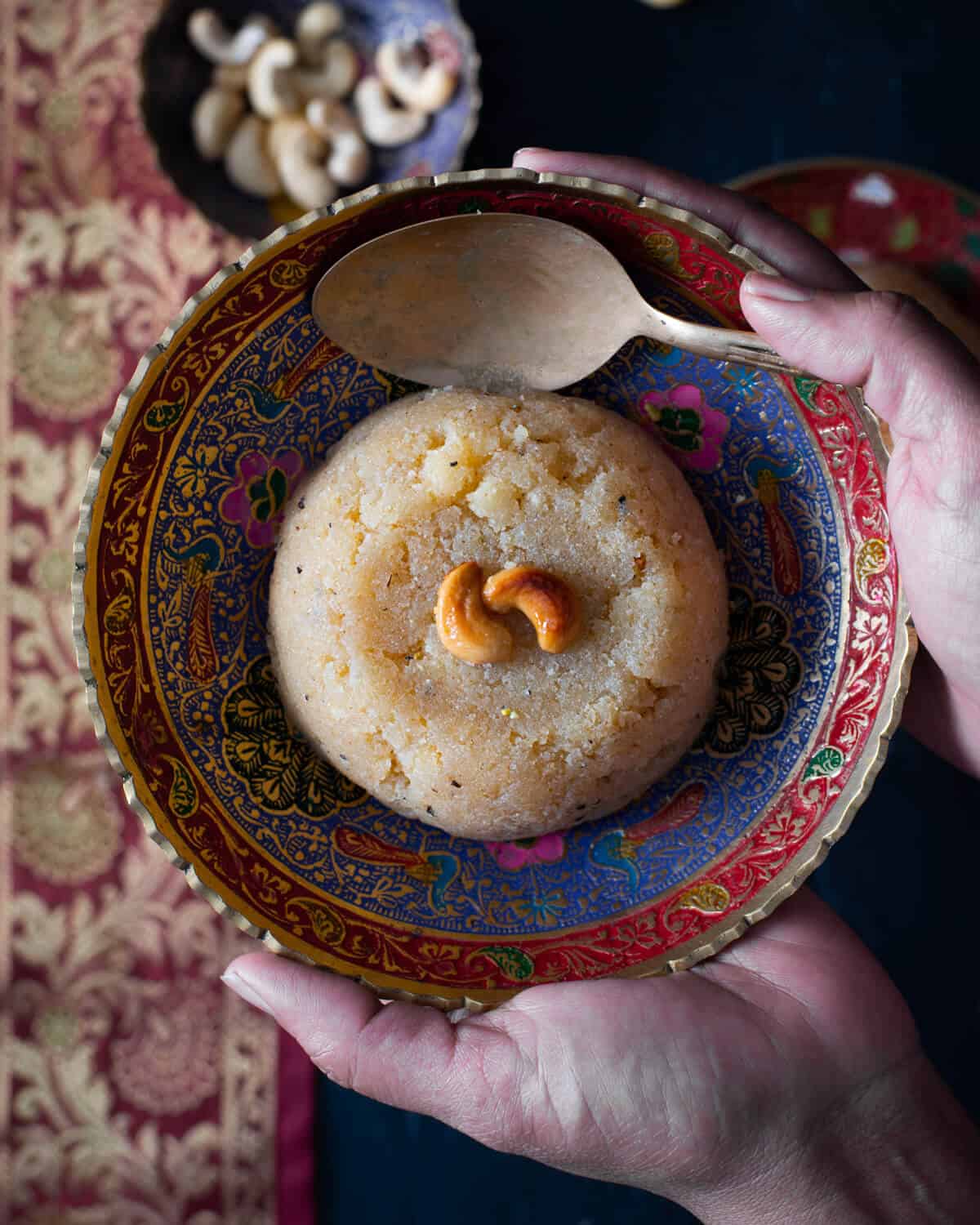
What’s sheera or suji ka halwa?
On this Indian semolina pudding recipe, semolina is roasted in ghee after which mixed with milk (or water), your selection of nuts, sugar, and cardamom powder to create a deliciously crumbly, sweet dish.
Folks from Karnataka comprehend it as sajjige, rava kesari, or kesari bhath. In north India, it is named suji ka halwa, whereas it’s popularly referred to as sheera in Maharashtra.
In actual fact, every country seems to have its own version. It goes by semolina pudding in Europe and the US, whereas folks within the Middle East have their very own variant called Lekhmat Al Helwa.
Often served as prasad (an offering to god) during festive occasions resembling Ganesh Chaturthi, ashtami, and Satyanarayana poojas, sheera holds a vital place in Indian cuisine.
Before we get to this easy recipe, let’s address the million-dollar query here.
Is sheera good for you?
Before we answer the query, let’s have a little bit chat about semolina – the important thing ingredient in sheera.
What’s semolina?
Semolina (rava / suji) is a rough flour comprised of durum wheat and is often golden or off-white in color. It’s used for making a wide range of dishes, including porridge, bread, and even pasta. It’s a high-gluten product that’s wealthy in vitamins, minerals, and carbohydrates.
Is semolina healthier than white flour?
Though each semolina and white flour are comprised of wheat, semolina is taken into account to be healthier than white flour.
White flour is bleached with a whitening agent, doesn’t have fiber or protein content in it, and is wealthy in carbohydrates.
Semolina, however, is comprised of durum wheat and is an excellent source of vitamins E and B. It’s slowly digested by the body, and hence, you’re feeling satiated after eating semolina.
Is semolina higher than whole wheat flour?
Semolina may appear just like whole wheat flour, but they’re quite different. To understand this distinction, it’s necessary to grasp the wheat kernel’s structure.
A wheat kernel comprises three parts: the bran (outer skin, wealthy in fiber and antioxidants), the endosperm (the kernel’s largest portion, filled with starchy carbs and proteins), and the germ (the embryo, loaded with healthy fats, proteins, vitamins, and minerals).
Whole wheat flour (referred to as atta in Hindi) is derived from the entire wheat kernel, including the bran, germ, and endosperm. In contrast, semolina (or rava) is produced solely from the endosperm.
Since semolina loses fiber, vitamins, and minerals within the means of being comprised of durum wheat, manufacturers often fortify it, enhancing its fiber and protein content to create an enriched product.
That’s why, compared to whole wheat flour, semolina is taken into account less healthy because the carbohydrate concentration in it’s higher.
To wrap it up, semolina offers the next advantages (source – Semolina for weight reduction).
- Boosts energy level because it accommodates carbohydrates.
- It’s wealthy in iron and helps in improving blood circulation within the body.
- It accommodates calcium and is nice on your bones.
- It is nice for the nervous system due to magnesium, zinc, and phosphorous.
- Semolina has zero cholesterol.
It’s an amazing once-a-month indulgence, though, but for those who want something healthy on your breakfast, this rava upma recipe comprised of semolina is an amazing selection.

How do you make the right sheera?
Nailing the right sooji halwa recipe starts with choosing the correct ingredients:
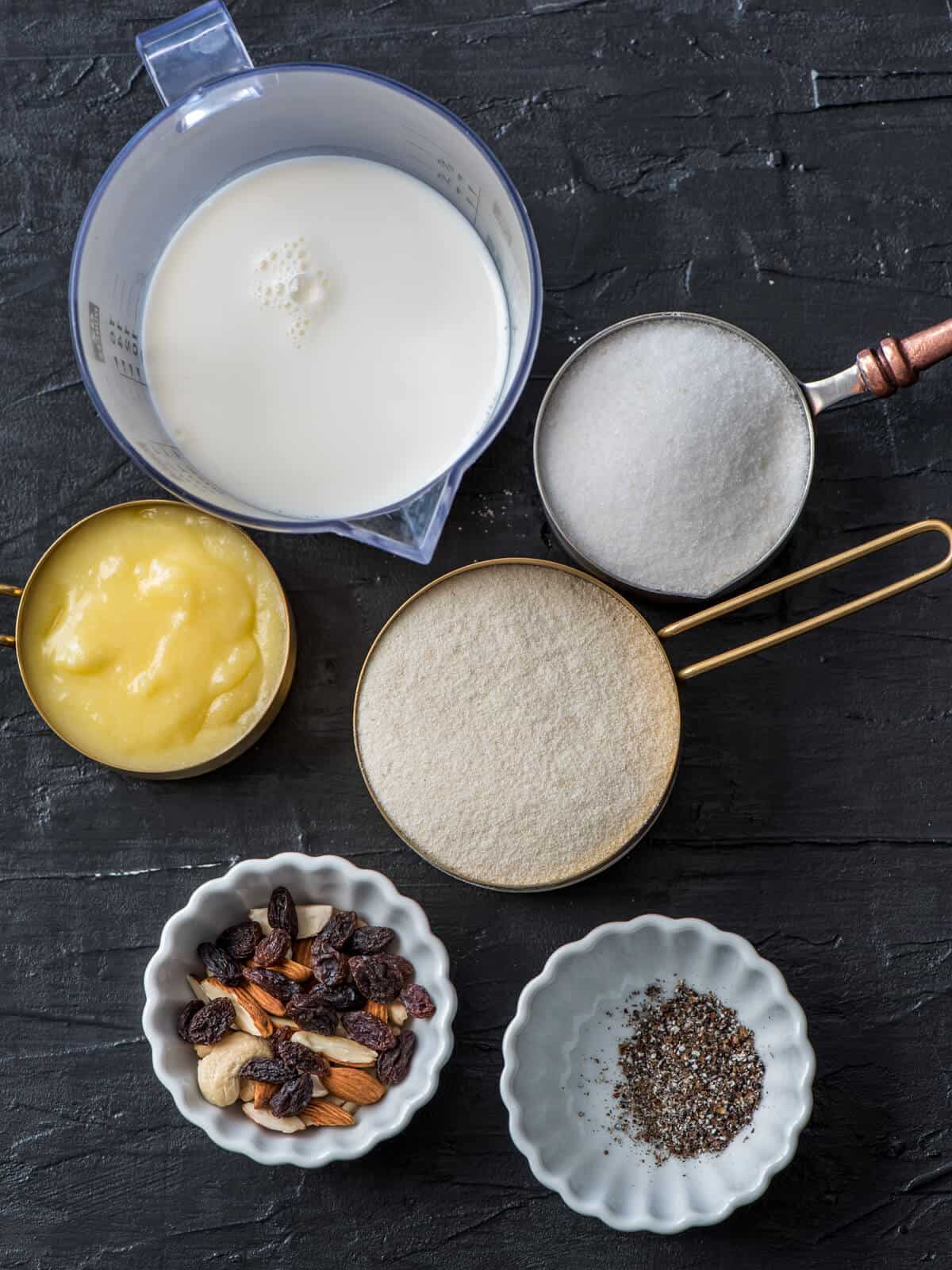
Many consider that making sooji halwa/sheera is sort of easy, but my initial attempts were removed from successful. My sheera often turned out clumpy, soggy, sticky, and greasy – a stark contrast to the finger-licking sheera served by my neighbor during kanya pooja.
Her sooji halwa was all the time a treat – perfectly sweet without being an excessive amount of, with a non-greasy, crumbly texture that disintegrated on the slightest touch. Achieving that perfect and delicious sooji ka halwa became my goal, and I’m thrilled to have mastered a recipe that replicates it.
Here’s how you may do it too –
- In a saucepan, bring water or milk to a boil.
- Heat ghee in a wok or kadhai on medium heat.
- Fry cashews and raisins in ghee until they turn golden brown.
- Add sooji to the wok and roast for 10-12 minutes until it’s evenly brown and fragrant.
- Lower the warmth to medium-low. Fastidiously pour the new liquid into the sooji mixture, stirring repeatedly to stop lumps.
- Let the halwa cook for a few minutes.
- When all of the liquid has been absorbed, add sugar and cardamom to the halwa and proceed cooking until the sugar is totally melted and absorbed. Once the halwa starts to depart the edges of the pan, turn off the warmth.
- Serve the halwa hot.
Sheera ratio: The key to perfect suji ka halwa lies in getting the proportions right. For each cup of semolina, use 3 cups of water or milk and 1 cup each of sugar and ghee.
Take a have a look at the detailed step-by-step pictures provided for making this delicious suja ka halwa, and be sure you follow the accompanying suggestions. This can assist you to create the right sheera all of us love and crave.
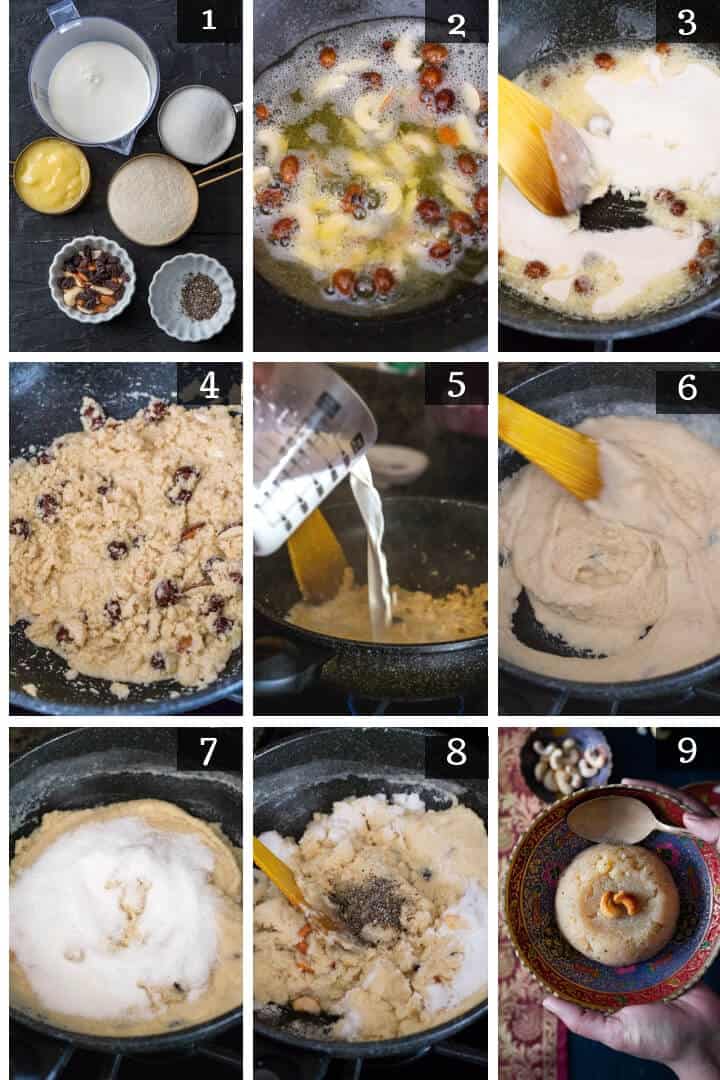
Suggestions for an ideal suji ka halwa recipe
- Follow the 1:1:1 ratio: Ideally, use equal amounts of semolina, sugar, and ghee for an authentic sheera recipe. Nonetheless, barely reducing sugar and ghee can still yield similar results. As an illustration, I typically use 3/4 cup of sugar and ghee for 1 cup of semolina.
- Roast semolina to golden brown: Roasting semolina in ghee over a slow flame for 10-12 minutes is crucial. This step prevents sticking and eliminates the raw taste. If using nuts, sauté them in ghee first, then add semolina.
- Reduce heat when adding hot water or milk: Lower the warmth before adding hot liquid to semolina to stop splattering.
- Stir immediately & continuously after adding liquid: Continuous stirring right after adding the liquid helps avoid lumps.
- Measure ingredients for those who’re a beginner: If latest to creating sheera, accurately measure ingredients. Getting the correct proportions may be very necessary.
- Balance the liquid content: Too little liquid results in dry sheera, while an excessive amount of makes it soggy and clumpy.
- Don’t skimp on ghee: Ghee not only adds flavor but additionally prevents the semolina from clumping together.
Storage instructions
Store any leftover sheera within the refrigerator for about 5-6 days. Heat before serving.
Variations
Now, there are a number of variations to this suji halwa recipe that you could try.
- Fruit-infused sheera: Add finely chopped pineapple or elaichi kela (banana) for a singular and delicious twist.
- Saffron sheera:
- Soak a pinch of saffron in warm water for 10 minutes.
- Mix the saffron-infused water with boiled water or milk.
- Add this mixture to roasted semolina for a fantastic yellow color.
- Rava kesari: Add a number of drops of artificial orange coloring while adding the liquid to attain a vibrant orange hue.
- Using sugar syrup:
- Dissolve sugar in boiling water, then add this syrup to the sheera.
- For a healthier option, use jaggery as an alternative of sugar (filter if needed for impurities).
- Half milk/Half water: Use either all milk or a mixture of half milk and half water for the liquid component.
Serving suggestions
Sheera is usually enjoyed for breakfast, as a dessert for special occasions, or as a night snack. To make prasad for ashtami, pair it with pooris and kala chana.
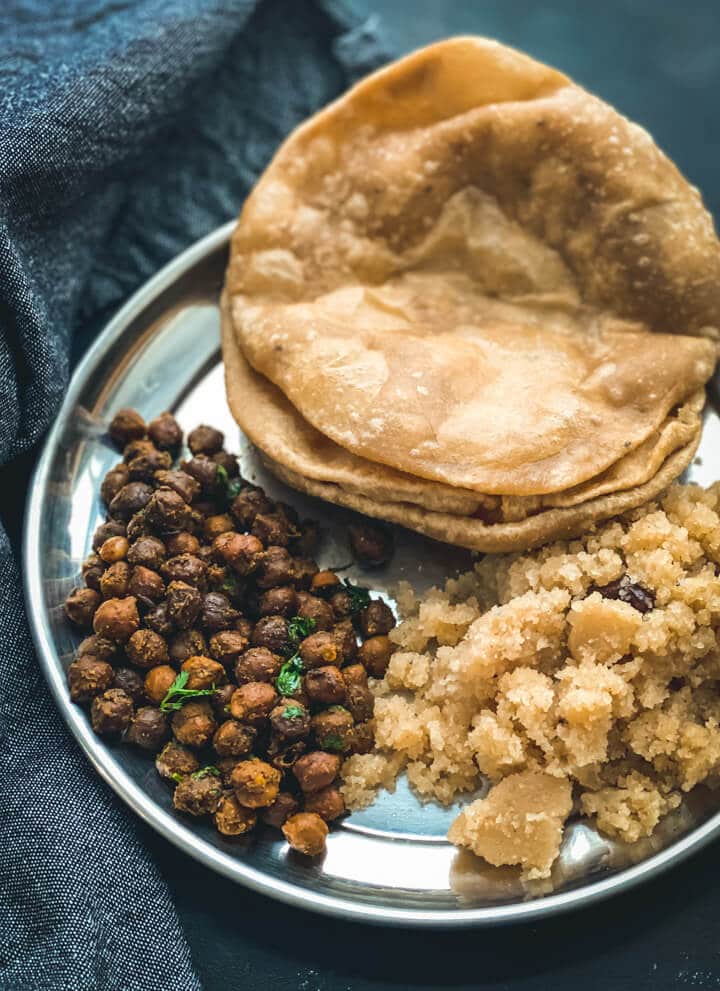
Other delicious Indian dessert recipes to enjoy
Need more dessert recipes? Try this list of 45+ easy Indian desserts and sweet recipes for whenever you need fresh ideas to wow your loved ones and friends.
Try our fail-proof sooji halwa recipe for a comforting, sweet treat that’s perfect for any occasion. Easy to follow and stuffed with flavor, this classic dessert is bound to please everyone!
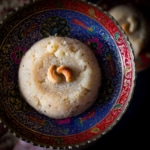
Sheera / Suji Halwa (Semolina Pudding)
Crumbly, sweet, and delicious – that’s how you’ll describe Sheera also referred to as Suji ka halwa. Learn to make this easy and traditional dessert in lower than half-hour.
Pin Print Save Email- ¾ cup ghee
- ¼ cup dry fruits halved cashews, almonds, raisins
- 1 cup high quality semolina suji
- 3 cups milk or water
- 1 cup sugar
- ¼ teaspoon cardamom seeds ground
Prevent your screen from going dark
-
- Follow the 1:1:1 ratio: Ideally, use equal amounts of semolina, sugar, and ghee for an authentic sheera recipe. Nonetheless, barely reducing sugar and ghee can still yield similar results. As an illustration, I normally use 3/4 cup of sugar and ghee for 1 cup of semolina.
-
- Roast semolina to golden brown: Roasting semolina in ghee over a slow flame for 10-12 minutes is crucial. This step prevents sticking and eliminates the raw taste. If using nuts, sauté them in ghee first, then add semolina.
-
- Reduce heat when adding hot water or milk: Lower the warmth before adding hot liquid to semolina to stop splattering.
-
- Stir immediately & continuously after adding liquid: Continuous stirring right after adding the liquid helps avoid lumps.
-
- Measure ingredients for those who’re a beginner: If latest to creating sheera, accurately measure ingredients. Getting the correct proportions may be very necessary.
-
- Balance the liquid content: Too little liquid results in dry sheera, while an excessive amount of makes it soggy and clumpy.
-
- Don’t skimp on ghee: Ghee not only adds flavor but additionally prevents the semolina from clumping together.
Storage instructions
Store any leftover sheera within the refrigerator for about 5-6 days. Heat before serving.Disclaimer: Approximate dietary information is provided as a courtesy and might vary depending on the precise ingredients/brands used. If you will have health issues, please work with a registered dietician or nutritionist.
Calories: 318kcalCarbohydrates: 37gProtein: 5gFat: 17gSaturated Fat: 10gCholesterol: 42mgSodium: 33mgPotassium: 149mgFiber: 1gSugar: 24gVitamin A: 119IUCalcium: 87mgIron: 1mg
Eating regimen: Vegetarian
Course: Breakfast
Method: Stovetop
Cuisine: Indian
This recipe was first published on Oct 16, 2018, and has been updated with text and directions on Dec 4, 2023.


